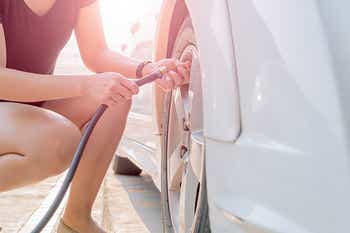Whether it’s a family trip to an amusement park or a cross-country adventure with friends, road trips are a part of American culture. However, the first step toward a fun-filled and safe excursion is to ask yourself, “Is my car ready for a road trip?”
Savvy drivers can find and take care of most minor vehicle issues by doing a little maintenance before hitting the highway. Follow this road trip checklist to make sure your car is ready before your next adventure.
Check Your Lights
Be sure all of your lights work properly, including headlights, tail lights, brake lights and turn signals. Don’t forget to check your high beams as you may need them on the road at night. Consult your vehicle owner’s manual to find out the correct way to change each light, or ask your local auto parts store to assist you.
Get an Oil Change
Not enough drivers ask themselves, “should I get an oil change before a road trip?” Oil is the lifeblood of your engine. Depending on how old your vehicle is and the type of oil you use in your car, you will need to change your oil every 5,000 to 10,000 miles. Make sure to check your levels and monitor how many miles you’ve driven since your last change. Keep in mind that older vehicles may need more frequent oil changes.
Is Your Air Conditioner Working?
Beat the summer heat by ensuring your air conditioner works before leaving on a road trip. If the outside temperature is over 80 degrees F, leave your car running for 15 minutes before placing a thermometer next to an air vent. Check the thermometer after five minutes. The air coming out should be around 15 to 20 degrees cooler than the outside temperature. You may need to top off your refrigerant levels or replace a leaky hose if it’s not.
Don’t Forget Your Phone Charger
Whether you’re using your phone for navigation or calling for emergency assistance, a mobile device is useless without power. Don’t forget to bring a charger, and always pull off the road before using your phone.
Keep an Eye on Your Air Filter
The air filter plays a significant role in engine performance by extracting dirt and dust particles from the air sucked into the engine. Most manufacturers recommend changing your air filter annually or every 12,000 miles, but check your vehicle owner’s manual for specific guidance on your car.
Check Those Brakes
Functioning brakes can make the difference between life and death. Check for damage or wear by looking at your brake pads through the spaces between the wheel’s spokes. The outside pad presses against a metal rotor. Typically, there should be at least 1/4 inch of pad. If you see less than 1/4 inch of pad, you should replace your brake pads.
Gauge Your Tire Pressure
Proper tire pressure is a vital safety concern. Use a tire pressure gauge to assess the amount of air in each tire. As a next step, consult your owner’s manual to find the recommended number of pounds per square inch (PSI). You might also find that information on the label inside the driver’s side door.
Replace Your Wiper Blades
Generally, you should replace your wiper blades every six months or as soon as you notice a difference in driving visibility. To check for damage, run a finger along the edge of the rubber blade. It’s time to replace them if you feel any cracks or splits.
Top Off Your Washer Fluid
Make sure your wipers have what they need to keep your windshield clean by checking your washer fluid. Do this by opening your hood and locating your washer fluid reservoir. If your vehicle has a rear wiper, there may be a second reservoir for it as well. Remove the cap, check the fluid level and top it off before your road trip.
Have an Emergency Kit
Prepare for any eventuality with an emergency kit for your vehicle. It should include road flares, jumper cables, a quart of motor oil, a gallon of coolant, first-aid kit, blankets, flashlight and basic tools like a screwdriver, pliers and adjustable wrench.
Create a Plan
On top of your vehicle checklist, do your homework and plan ahead for the journey. What’s the weather forecast on your intended route, and is there a chance of any dangerous weather conditions like snow or floods? Are there any road closures or planned maintenance?
Do you know where you’ll fuel up during the journey? Don’t forget that some states like Arizona have much cheaper gas than others like California. Keep this in mind when traveling between states, and consider fueling up where gas is least expensive.
Preparation is vital for all forms of travel, but especially for long road trips. Remember to ask yourself or your mechanic these important questions, “Is my car ready for a road trip,” and, “Should I get an oil change before a road trip?”
While you may not need to have every step of the journey planned to the minute, conducting a road trip check prior to hitting the highway can help make sure you enjoy an epic excursion.


